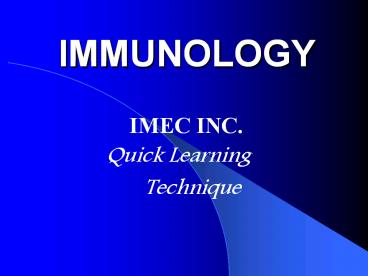Complete Immunology for Medical Students - PowerPoint PPT Presentation
Title:
Complete Immunology for Medical Students
Description:
(PRICE LOWERED)Complete Immunology for the USMLE – PowerPoint PPT presentation
Number of Views:568
Updated: 17 December 2015
Slides: 45
Provided by:
drstingrae
Category:
Medicine, Science & Technology
Tags:
Why and how:
Dr. Raepsaet and the IMEC staff are attempting to give the best and most proven methods of covering the topics for the USMLE
Title: Complete Immunology for Medical Students
1
IMMUNOLOGY
- IMEC INC.
- Quick Learning
- Technique
2
(No Transcript)
3
Immunoglobulins
4
Immunoglobulins
- The plasma proteins can be separated into
different fractions by electrophoresis. The
slowest migrating fraction is called
gammaglobulins. - Immunoglobulin is by definition protein with
antibody activity. - The molecules are built from 4 polypeptide chains
linked together with disulfide bonds. 2 of the
chains are called light chains (L-chains) and the
other heavy chains (H-chains). The light ones are
of 2 types, K and L, and they are common for all
immunoglobulins.
5
(No Transcript)
6
IgG
- IgG is the antibody existing in serum to the
largest amount and it takes over from IgM during
long lasting antigen influence.
7
IgG
8
IgM
- IgM is the first created immunoglobulin when the
organism is affected by an antigen. It has a very
great bonding ability, totally 10 connection
points per molecule. IgM complement and acts
mainly because of this bonding. - REFER TO ORIGINAL SLIDE
9
IgE
- IgE is found in low concentration in serum but is
responsible for a variety of allergic reactions.
10
IgA
- IgA is bound to the secratory system and is
found in salvia, intestinals, lungs and also
highly concentrated in colostrum (mother's milk).
- IgA is of great importance to the projection of
our inner epithelial cells. - IgA is found in the secretions as a monomer but
the majority is dimer - Apart from the 2 light and the 2 heavy chains
dimer IgA also contains one J-chain and an extra
polypeptide chain called "Secretory Component".
11
IgA
- Heavy, light and J-chains are synthesized in
plasma cells and Secretory Component of the
epithelial cells. - IgA reaches a compact structure giving it a
special resistance against proteolytic enzymes. - IgA is capable of neutralizing toxins and
blocking virus. Unlike IgM the cytological effect
on bacteria does not depend on complement but
merely on a co-operation between IgA and
lysozyme. - IgA plays an important role in local infection
defense of the mucous membranes.
12
IgD
- IgD is biochemically much alike the
immunoglobulins but of no certain biological
function.
13
(No Transcript)
14
(No Transcript)
15
Knockout Mice
16
Immune Response
17
(No Transcript)
18
MAST CELL RELEASE TO IgE SITE
19
B-LYMPHOCYTES
- Humoral Immune Response
- Arise from stem cells in Bone Marrow
- Migrate to peripheral lymph
- White Pulp of Spleen, Follicles of lymph nodes
- When Antigen is encountered, B-cells
differentiate into Plasma Cells - Produce Antibodies
- Have Memory
- Can function as APC cells via MHC class II
20
T-LYMPHOCYTES
- Mediates Cellular IMMUNE Response
- Maturation is in Thymus
- MHC 2 X CD 4 8 helper
- MHC 1 X CD 8 8 suppressor
- CD-Cluster of differentation
- Unlike Mast cell-?T-cell (delayed
hypersensitivity)
21
(No Transcript)
22
Cellular Processing
- T-cells differentiate in the thymus, and have
a specific receptor for a fragment of antigen.. - Cytotoxic T-cells contain a surface protein
called CD8 and destroy pathogen infected cells,
cancer cells, and foreign cells (transplanted
organs). - Helper T-cells contain a surface protein called
CD4 and regulate both the cellular and humoral
immune systems. This regulation reduces
autoimmunity. - Autoimmune disease- self immunity. Some examples
include rheumatic fever, rheumatoid arthritis,
ulcerative colitis, myasthenia gravis, etc.
23
T-Helper Cells
24
Cytotoxic T Lymphocyte
25
MHC I linking to T-cell Receptor
26
(No Transcript)
27
(No Transcript)
28
(No Transcript)
29
ANTIGEN PROCESSING
30
PLASMA CELLS
- Off Center Nucleus
- CLOCK SHAPED CHROMATIN DISTRUBUTION
- Abundant RER, well developed Golgi
- Come from B-Cells
- Produce large amounts of antibody specific to
antigen - Multiple Myeloma is Plasma Cell Neoplasm
31
(No Transcript)
32
Cytokines
- The term Cytokine refers to soluble, antigen
non-specific, signaling proteins that bind to
surface receptors on a variety of cells. - Types
- IL ( Interleukins)
- IFN (Interferons)
- TNF (Tumor Necrosis Factors)
- CSF (Colony Stimulating Factors)
33
(No Transcript)
34
(No Transcript)
35
IL-1
- Enhances the activity of NK cells
- Attracts Neutrophils and Macrophages
36
IL-2
- Introduces proliferation of antigen-primed
T-Cells - Enhances activity of Natural Killer Cells
37
IL-3
- IL-3 is a hematopoietic (blood
- growth) factor that promotes the growth and
differentiation of several types of blood cells
(red, white, and platelets).
38
IL-4
- IL-4 is released by a subset of CD4 cells, and
helps stimulate antibody production.
39
IL-6
- IL-6 is produced by macrophages and mediates
acute systemic immune responses (e.g., fever).
40
IL-8
- IL-8 stimulates the growth of new blood vessels.
41
IL-10
- IL-10 stimulates the proliferation and activity
of B-cells. modulates macrophage function, and
enhances humoral macrophage function, and
enhances humoral (TH2) immunity, while
suppressing cell-mediated immune function
42
IL-12
- IL-12 is produced by various immune cells (e.g.,
monocytes, macrophages, dendritic cells, and
neutrophils), and activates natural killer cells
and cytotoxic T-lymphocytes and induces the
production of interferon-gamma. IL-12 is
associated with the cell-mediated immune
response.
43
INF-y
- Enhances activity of NK Cells and Macrophages
- Increase expression of MHC molecules
- Enhances production of IGg
44
TNF-a
- Cytotoxic Effect on Tumor Cells
- Induces Cytokine Secretion in the inflammatory
Response































